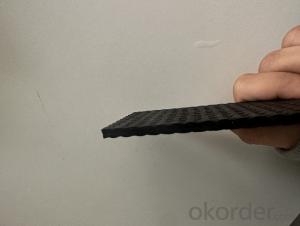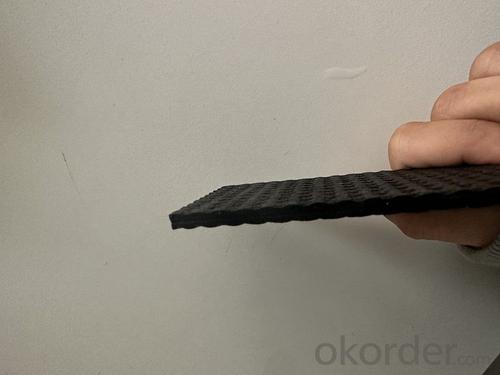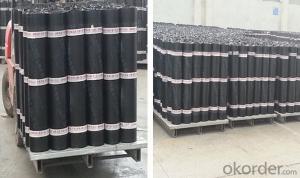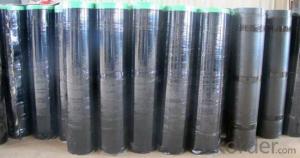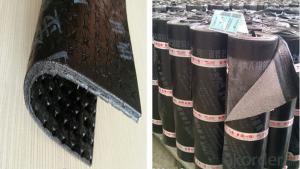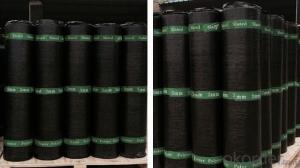Elastomer(SBS)Modified Bitumen Waterproofing Membrane
- Loading Port:
- China main port
- Payment Terms:
- TT OR LC
- Min Order Qty:
- 10 m²
- Supply Capability:
- 800000 m²/month
OKorder Service Pledge
OKorder Financial Service
You Might Also Like
Specification
01 Product introduction Product Introduction
Jiuyang Elastomer (SBS) modified asphalt waterproof coil adopts thermoplastic elastomer (styrene-butadiene-styrene) modified asphalt as dipping coating material. With high quality polyester felt as the base, both sides coated with elastomer asphalt coating, with fine sand, mineral particles (sheets), PE film, aluminum film and other coating materials, the elastomer modified asphalt waterproof sheet is refined by advanced technology. The product has good waterproof performance and anti-aging performance. It has the characteristics of no flowing at high temperature, no brittle cracking at low temperature, simple construction and no pollution.
02 Product characteristics
1. Strong impermeability.
2. High tensile strength, large elongation, good dimensional stability and strong adaptability to base shrinkage deformation and cracking.
3. Good high and low temperature resistance, suitable for building waterproof in low temperature environment.
4. Puncture resistance, crack resistance, tear resistance, corrosion resistance, mildew resistance, weather resistance.
5. Convenient construction, hot melt construction four seasons can be operated, reliable joints.
03 Applicable scope
1. Widely used in roofing, basement, toilet, pool and other waterproof and moisture-proof of industrial and civil buildings, bridge, parking lot, swimming pool, tunnel, reservoir and other buildings, waterproof, moisture-proof, gas insulation, anti-seepage and asphalt roofing maintenance projects.
2. SBS modified asphalt waterproof coil is especially suitable for building waterproofing in cold areas and areas with frequent structural deformation.
04 Packaging and storage andtransportation
1. During transportation and storage, different types and specifications of products should be stored separately and should not be mixed. Avoid sun and rain, pay attention to ventilation.
2. Storage temperature should not be higher than 50℃, vertical storage can only be single layer.
3. Prevent tilt or transverse pressure during transportation, and cover felt cloth if necessary.
4. Under normal transport and storage conditions, the storage period is one year from the date of production.
- Q: Does a waterproofing membrane require any specific safety precautions during installation?
- Specific safety precautions are necessary when installing a waterproofing membrane. Consider the following key precautions: 1. Personal Protective Equipment (PPE): Installers must wear appropriate PPE, such as gloves, safety glasses, and protective clothing, to avoid skin contact with the membrane and potential chemical hazards. 2. Adequate Ventilation: Ensure that the installation area has proper ventilation to prevent the accumulation of fumes or vapors. If working in a confined space, use ventilation systems to eliminate any potentially harmful gases or odors. 3. Hazardous Chemicals: Some waterproofing membranes contain hazardous chemicals or solvents. Installers should carefully read and adhere to the manufacturer's instructions for handling and using these products. Proper storage, handling, and disposal of chemicals are crucial to prevent accidents or environmental contamination. 4. Slips and Falls: The surface can become slippery during installation, particularly when applying the membrane on wet surfaces. Installers should take precautions to maintain stability and utilize safety equipment like harnesses or guardrails when working at heights to prevent falls. 5. Heat Hazards: Proper installation of certain waterproofing membranes requires the use of heat. Installers should exercise caution when working with heat sources such as torches or heat guns to prevent burns or fire hazards. Keep fire extinguishers readily available and ensure that personnel receive adequate training on fire safety protocols. 6. Electrical Safety: Waterproofing membranes might be installed in areas where electrical systems are present. Installers should exercise caution when working near live electrical wires or outlets and adhere to proper electrical safety procedures to prevent electric shocks or fires. It is crucial for installers to undergo comprehensive training and diligently follow all safety guidelines provided by the manufacturer. This will help minimize the risk of accidents, injuries, or property damage during the installation process.
- Q: Can a waterproofing membrane be used for a swimming pool liner?
- Yes, a waterproofing membrane can be used as a swimming pool liner. Waterproofing membranes are designed to provide a barrier against water penetration, making them suitable for use in swimming pools to prevent leaks and maintain the water integrity.
- Q: What is the difference between polymer waterproofing membrane and cross film waterproofing membrane?
- The use of high-quality pressure-sensitive adhesive adhesive layer, with the concrete base of the rapid combination of its excellent self-healing properties and local self-locking water performance greatly reduce the penetration rate. The polymer in the coil material reacts with the cement compound to form an interpenetrating network structure, which eventually forms a continuous mechanical bond and is permanently sealed on the cementitious material member.
- Q: Can a waterproofing membrane be used on precast insulation surfaces?
- Yes, a waterproofing membrane can be used on precast insulation surfaces. A waterproofing membrane is designed to provide a protective barrier against water infiltration, and it can be applied to a variety of surfaces, including precast insulation. The membrane helps to prevent water from seeping into the insulation, which can cause damage and reduce its effectiveness. By applying a waterproofing membrane to precast insulation surfaces, you can ensure that the insulation remains dry and maintains its thermal properties over time.
- Q: Are waterproofing membranes resistant to gasoline vapors?
- Yes, waterproofing membranes are generally resistant to gasoline vapors. They are designed to create a barrier against moisture and other liquids, including gasoline and its vapors.
- Q: Can waterproofing membranes be used on elevator pits?
- Yes, waterproofing membranes can be used on elevator pits. Elevator pits are prone to water infiltration due to their location below ground level, making them susceptible to water damage and leaks. Waterproofing membranes provide an effective solution to prevent water penetration and protect elevator pits from moisture-related issues. These membranes are designed to create a watertight barrier, usually made of materials such as rubber, polyurethane, or bitumen. They are applied to the walls and floor of the elevator pit, forming a seamless and durable protective layer. This membrane system helps to keep the pit dry, preventing water damage to the elevator components and ensuring the safe and reliable operation of the elevator.
- Q: Can a waterproofing membrane be used for elevator pits or sump pits?
- Yes, a waterproofing membrane can be used for elevator pits or sump pits. Elevator pits and sump pits are areas that are prone to water intrusion, so it is important to protect them from water damage. A waterproofing membrane is designed to create a barrier against water, preventing it from seeping into the pits and causing damage to the structure or equipment. By applying a waterproofing membrane to the walls and floors of elevator pits or sump pits, it helps to keep the area dry and free from water infiltration. This can help extend the lifespan of the elevator or sump pump system and prevent costly repairs in the future. It is important to properly install and maintain the waterproofing membrane to ensure its effectiveness and longevity.
- Q: Can a waterproofing membrane be used on swimming pool decks?
- Indeed, swimming pool decks can benefit from the use of a waterproofing membrane. The purpose of these membranes is to effectively block water infiltration, which makes them particularly suitable for safeguarding areas that are constantly exposed to moisture, like swimming pool decks. Typically, these membranes are applied directly onto the deck's surface, creating an impermeable and long-lasting layer. This ensures that water does not permeate the deck, thus averting potential harm caused by dampness, such as cracks, the growth of mold, or structural decline. Furthermore, waterproofing membranes offer additional advantages, including prolonging the lifespan of the deck and enhancing its overall aesthetic appeal.
- Q: How long does it take for a waterproofing membrane to dry?
- The drying time of a waterproofing membrane can differ based on various factors, including the kind of membrane used, prevailing weather conditions, and the method of application. Typically, it will take a minimum of 24 to 48 hours for most waterproofing membranes to completely dry. It is crucial to refer to the instructions provided by the manufacturer for precise drying times, as they might vary. Furthermore, factors such as temperature, humidity, and ventilation can impact the drying process. It is advisable to guarantee adequate ventilation and allocate enough time for the membrane to dry before exposing it to any moisture or foot traffic.
- Q: Can a waterproofing membrane be used for parking garages?
- Yes, a waterproofing membrane can be used for parking garages. A waterproofing membrane is a protective layer that is applied on surfaces to prevent water penetration. In parking garages, it is essential to have effective waterproofing to protect the structure from water damage, such as corrosion of steel reinforcement and deterioration of concrete. Parking garages are exposed to various sources of water, including rain, snow, and vehicle fluids, which can seep through cracks and joints. A waterproofing membrane acts as a barrier, preventing water from infiltrating the structure and causing damage. There are different types of waterproofing membranes available for parking garages, including sheet membranes, liquid-applied membranes, and cementitious coatings. These membranes can be applied on horizontal and vertical surfaces, such as floors, walls, and ramps, to create a watertight seal. When selecting a waterproofing membrane for a parking garage, factors such as durability, flexibility, and resistance to chemicals should be considered. The membrane should be able to withstand the heavy loads and traffic conditions typically found in parking garages. Overall, using a waterproofing membrane in parking garages is crucial to protect the structure and extend its lifespan by preventing water-related damage. It helps maintain the structural integrity and aesthetics of the garage while ensuring a safe and functional environment for users.
Send your message to us
Elastomer(SBS)Modified Bitumen Waterproofing Membrane
- Loading Port:
- China main port
- Payment Terms:
- TT OR LC
- Min Order Qty:
- 10 m²
- Supply Capability:
- 800000 m²/month
OKorder Service Pledge
OKorder Financial Service
Similar products
Hot products
Hot Searches
Related keywords
